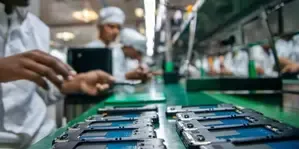US Tariffs: India’s Tech Hardware Sector Poised to Surpass China and Vietnam

Synopsis
Key Takeaways
- India's tariff stands at 27%, lower than China's 34% and Vietnam's 46%.
- The shift in supply chains could boost India's smartphone manufacturing.
- Apple and Samsung already have significant operations in India.
- Dixon Technologies is positioned to gain from these changes.
- The Electronics Component Manufacturing Scheme aims to create substantial job opportunities.
New Delhi, April 8 (NationPress) With China facing a hefty 34% US tariff and Vietnam encountering 46%, India's comparatively lower tariff of 27% could transform supply chain dynamics, fostering further growth in the domestic tech hardware sector, as indicated by a recent report.
India’s electronics manufacturing, particularly in the realm of smartphones, is anticipated to gain a competitive advantage as the US enforces tariffs on electronics imports from significant countries, according to insights from a CLSA report.
The global supply chain shift could particularly benefit India in the smartphone manufacturing sector, the report elaborates.
Smartphones represent $51 billion worth of imports for the US, with China, Vietnam, and India being prominent suppliers, as per global brokerage analysis.
Apple and Samsung have already established strong manufacturing operations within India.
India's lower tariff, paired with its vast domestic market and advancing backward integration bolstered by the Production-Linked Incentive (PLI) scheme, elevates its cost-competitiveness.
Dixon Technologies is expected to be a significant beneficiary from this shift in global supply chain dynamics.
While Apple and Samsung's assembly operations are primarily in-house or with non-Indian companies, Dixon's influence in the supply chain is projected to expand, according to CLSA.
Other reports suggest that the anticipated direct effects of US reciprocal tariffs will differ across sectors in India. The impact is anticipated to be largely neutral for sectors such as electronics, textiles, agricultural products, chemicals, and automotive parts.
In the electronics sector, increased reciprocal tariffs on China would imply a neutral impact on India’s electronics exports, as noted in a report by CareEdge Ratings.
In addition, the recently introduced Rs 22,919 crore Electronics Component Manufacturing Scheme (ECMS), which has the potential to create nearly 100,000 direct jobs and numerous indirect positions, aims to boost local production of sub-assemblies and essential components like inductors, resistors, PCBs, and capacitors.
The scheme is projected to attract investments of Rs 59,350 crore, lead to production worth Rs 4,56,500 crore, and generate an additional 91,600 direct jobs along with many indirect employment opportunities throughout its duration.
Over the past decade, production has increased fivefold (17% CAGR) to reach Rs 9.5 lakh crore by 2024, resulting in the creation of 2.5 million jobs.
Exports have seen a sixfold increase (43% CAGR) to reach Rs 2.4 lakh crore by 2024. Electronics products now rank among India’s top three export categories.









